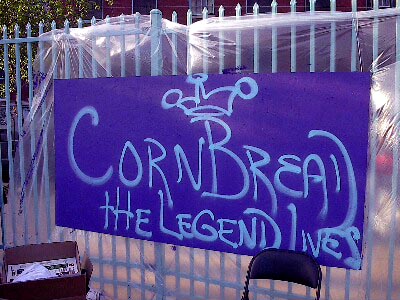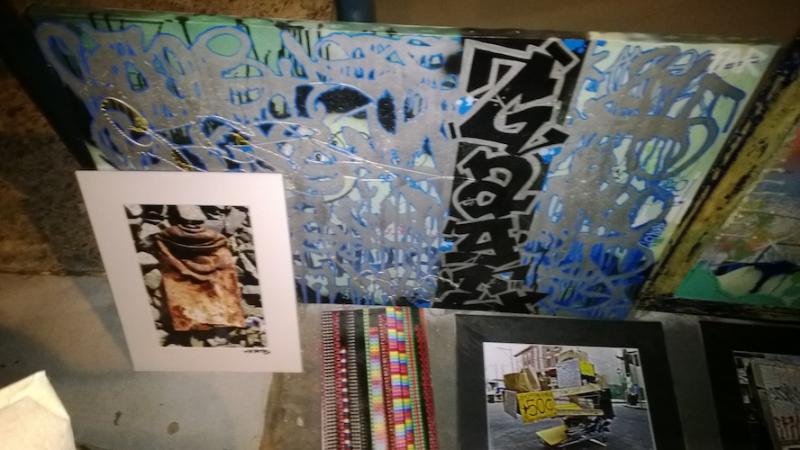Serendip is an independent site partnering with faculty at multiple colleges and universities around the world. Happy exploring!
Tag-A-Long

 |
 |
Philadelphia, 1967: Darryl McCray begins painting his nickname, “Cornbread”, on the streets of North Philadelphia to get a girl’s attention.
Philadelphia, 1984: The Philadelphia Anti-Graffiti Network (PAGN) is established to combat vandalism.
Philadelphia, 2013: The battle over graffiti rages on.
Philadelphia’s First Friday is an art festival of sorts that Old City organizes on the first Friday of every month. Rain or shine, fine art galleries between Front and Third, and Market and Vine streets can be found with open doors welcoming world-weary Philadelphians into their wine-scented interiors.
The event shows off the fine arts scene of Philadelphia by allowing the general public the freedom to wander from gallery to gallery, seeing what artists from all parts of the world are doing. However, lining the sidewalks outside the galleries are artists and craftspeople eager to sell their works and wares to fellow Philadelphians. Unlike the galleries, which, in my opinion, lend themselves more to “art for artists”, the street vendors sell everything from still lifes to caricatures, and woven bracelets to sculptures. A particularly intoxicated man even tried to sell us “Pennsylvania Pride” shirts.
Even though the purpose of First Friday was to visit the gallery open houses, the street vendors were much more intriguing. Prevalent, but not overwhelming, was the presence of the graffiti art style in the pieces being sold on the street. Some pieces were made with spray-paint and elaborate stencils on canvases, not unlike Banksy’s style, while others were more influenced by the traditional tags and wall-writing that the covers many Philadelphia buildings.
 |
I didn’t want to take too many pictures of the art, because I think it’s disrespectful to take pictures of art that is for sale instead of actually buying it, but I also didn't have money.
The “tagging” style seen here was, in fact, invented in Philadelphia. In 1967, Daryl McCray began painting his name around North Philadelphia and became the “father of graffiti writing”(Various). His self-proclaimed original intent was to get a girl he liked to notice him, but his writing morphed into a way for him to stay out of gang violence in Philadelphia and become a mild celebrity. Gang members of Philly even specially asked him to make graffiti-writing love poems for their girlfriends (Currier). However, McCray’s fame never extended far beyond the street art circles, never gaining the credibility of such “professional” street artists as Jean-Michel Basquiat and Shepard Fairey.
But what separates the “fine artists” from the “vandals”? Basquiat, for example, tagged subway trains in the 70s, and sold his art on shirts and postcards to make ends meet (Bio.com), not unlike the artists lining the streets at First Friday. In fact, in Basquiat’s career, it seems the only thing separating his art from that of other street artists of the time was the thin pane of glass in an art gallery window. Outside, his art was only worth the cost of the paint it took to make it, but inside a gallery, with a more professional nametag attached to it, Basquiat’s pieces would go for $50,000 or more.
|
Jean-Michel Basquiat, Bird on Money |
|
Jean-Michel Basquiat, Leeches |
Howard Becker describes the difference between graffiti as a deviant subculture versus a fine art as how the public and art world react to their endeavors (Lachmann 231); meaning that although the artist’s motivations are a large part of whether or not the graffiti is labeled vandalism, the real decision comes from the opinions of outsiders. Whether or not the art is trying to make a statement is irrelevant; it is how the message is or isn’t received that matters in terms of graffiti’s acceptance as art.
The marginalization of graffiti based on the reactions of viewers also brings in Flanagan’s notion of Critical Play, through which the viewer is encouraged to challenge their views. Graffiti can challenge both through its messages and through how the viewer perceives it: subversive high art that happens to be on a building, or a scribble marring an otherwise perfectly nice streetscape.
Flanagan, Mary. Introduction. Critical Play: Radical Game Design. Cambridge, MA: MIT, 2009. 1-15. Print.





Comments
Abby's first paragraph
Abby's first paragraph briefly introduces the event and setting. When I read her essay, I had flashbacks to the several Basquiat exhibits I have seen and how they've compared to her experience. She lightly touched on the artist's background and history. Abby plays through her use of pictures which allows the reader to clearly picture her experience through the works of art.
In the first paragraph, Abby
In the first paragraph, Abby introduces the festival and describes some scenes of the festival.
She uses some interesting adjectives, and without telling readers why she puts those adjectives there, she makes me think about: Why are Philadelphians world-weary? Why are the interiors wine-scented?
She plays by writing such a short opening paragraph to give readers more space of imagination. In addition, the description is very specific, and thus makes me want to find out why she describes like this in the following essay. I don’t know why, the first paragraph just makes me think of drunken people wandering in the streets with abstract paintings on one side of the street.